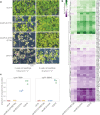A synthetic RNA editing factor edits its target site in chloroplasts and bacteria
- PMID: 33972654
- PMCID: PMC8110955
- DOI: 10.1038/s42003-021-02062-9
A synthetic RNA editing factor edits its target site in chloroplasts and bacteria
Abstract
Members of the pentatricopeptide repeat (PPR) protein family act as specificity factors in C-to-U RNA editing. The expansion of the PPR superfamily in plants provides the sequence variation required for design of consensus-based RNA-binding proteins. We used this approach to design a synthetic RNA editing factor to target one of the sites in the Arabidopsis chloroplast transcriptome recognised by the natural editing factor CHLOROPLAST BIOGENESIS 19 (CLB19). We show that our synthetic editing factor specifically recognises the target sequence in in vitro binding assays. The designed factor is equally specific for the target rpoA site when expressed in chloroplasts and in the bacterium E. coli. This study serves as a successful pilot into the design and application of programmable RNA editing factors based on plant PPR proteins.
Conflict of interest statement
The authors declare no competing interests.
Figures





References
Publication types
MeSH terms
Substances
Associated data
LinkOut - more resources
Full Text Sources
Other Literature Sources
Molecular Biology Databases

